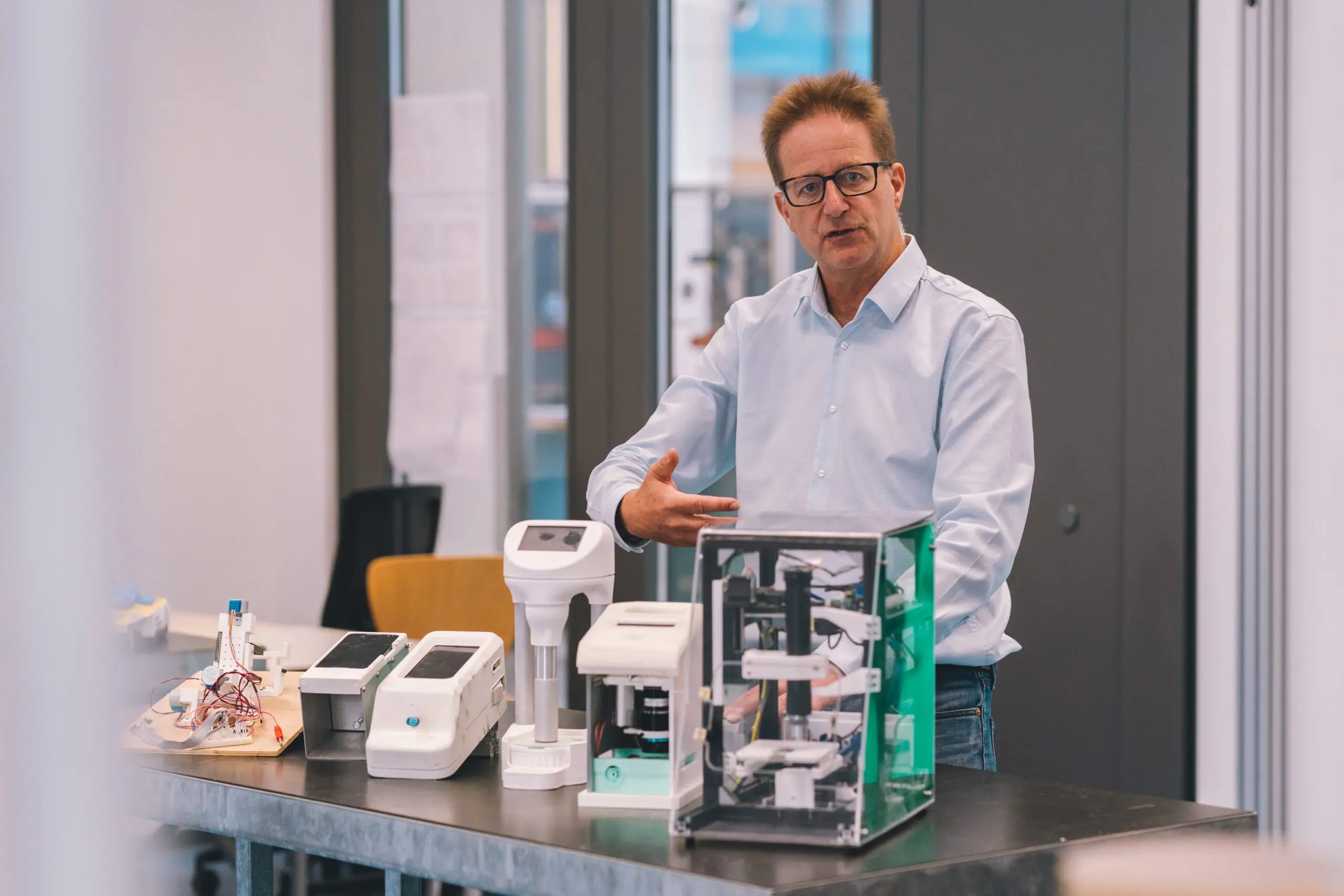You do not need expensive equipment to identify dangerous parasites. It can be done easily with locally available parts. The ‘schistoscope’ proves this. In theory, this digital microscope can be put together like an IKEA package.
Jan Carel Diehl demonstrates the schistoscope, a digital microscope that can detect the schistosomiasis parasite. (Photo: TU Delft)
The schistoscope looks like a roasting oven and can be easily built with a 3D printer, laser cutter and soldering iron. It works on a Raspberry Pi, a cheap and easily available single board computer. The device, which can be used in the tropics to detect schistosomiasis parasites, does not need wi-fi or mobile connections.
The microscope can detect the worms that cause schistosomiasis (bilharzia) in urine samples. The microscope was originally the idea of Temitope Agbana (Faculty of ME) who won an award for his algorithm in 2017. Professor JC Diehl (Sustainable Healthcare at the Faculty of IDE) joined the project for the device’s development.
Tropical illness
Every year about 250 million people are infected by schistosomiasis, the disease that the schistosomiasis parasite causes in standing water in the tropics. The risk is high in less built up areas such as river banks in Sub-Sahara Africa where children play and people wash clothes in the water. Without treatment, the eggs of the flatworm accumulate in the organs. This can lead to serious complications such as kidney failure, lung problems and bladder cancer.
A good diagnosis now still needs trained microscopy researchers. But they are scarce and often prefer working in big cities. The schistoscope that was developed at TU Delft allows local doctors in remote areas to detect the parasite themselves. They simply insert a urine sample and the digital microscope then scans it for parasite eggs.
‘You can compare open hardware with an online recipe book’
Home-made
To make the schistoscope widely available around the world, Diehl came up with the idea of making its development and building open source. He called on the help of Jerry de Vos, who had previously graduated under him and is one of the pioneers of the Open Hardware movement at TU Delft. “You can compare open hardware with an online recipe book,” explains De Vos. “There are basic recipes which you need ingredients for. You just follow the steps and make the dish.”
The documentation of an open hardware project includes a list of the materials needed and a step-by-step description for assembly. It continues with colourful illustrations of product parts in ‘IKEA-like style’. The code rules for the technical components can be obtained from a link on an online software development platform. Users can vary them and respond to each others’ questions. “This is also to avoid us becoming a sort of helpdesk,” laughs De Vos.
Locally tested
The team designed the schistoscope with the intention of people being able to replace the local parts and repair it. They built a few examples at the IDE Faculty and went to Nigeria to test it.
When something broke, local employees repaired it in a makerspace, an open workshop in the city. “It does mean that some people may have to drive for eight hours with that thing on the back of their motorbike to the city, but at least it does not have to be sent to the other side of the world to be repaired,” says De Vos.
‘Finding a replacement for a part which does something very specific is complicated’
In theory, the schistoscope can be built from scratch in a makerspace, but at the moment Diehl thinks that this is a step too far. “Products and suppliers always change. If a part is no longer available, you have to find an alternative. And finding a replacement for a part which does something very specific is complicated.”
And that brings risks. As anyone can make it themselves and adapt the instructions, the quality can no longer be guaranteed. Diehl gives one example. “If someone copies the schistoscope but puts in a wrong lens that is not sharp, he will not see the eggs and make a wrong diagnosis.”
Moral obligation
De Vos notes that it is medical projects in general that are open to open hardware. If a medical device is not patented, people can copy, modify and improve it freely, thus building on each others’ knowledge. “This means that patients benefit more from an innovation.”
“I see it as a kind of moral obligation,” says Diehl. “If you have the opportunity to come up with something beneficial with public money, you should make it as transferable as possible.”
De Vos and Diehl do not know how often the documentation of the schistoscope has been downloaded or whether people have really built one. “I don’t contact the author of a recipe every time I cook something,” says De Vos. “We do this in the hope that it is picked up somewhere.”
Open Hardware Stimulation Fund
Hardware engineer Jerry de Vos (IDE), software engineer Jose Urra Llanusa (Digital Competence Center) and data steward Santosh Ilamparuthi (EEMCS) are the pioneers of the Open Hardware movement at TU Delft. They started with small meetings for anyone interested in 2019. They quickly received support from the Open Science programme at TU Delft and started the Open Hardware Academy. Its goal is to familiarise students with open documentation.
In 2024, the specialised staff members left because of cutbacks. There was still money to set up a fund, the Open Hardware Stimulation Fund, in which research groups could hire student assistants to supply their projects with open documentation.
“Students and researchers will always share their knowledge and hardware designs,” De Vos points out, “but the scale and the impact of initiatives such as the schistoscope will always depend on the financing that is made available at TU Delft.”



Comments are closed.